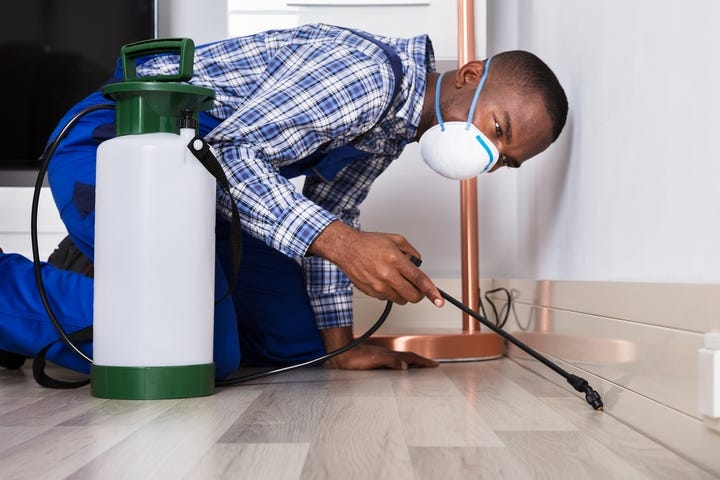Relied on Exterminator Near Me: Your Regional Pest Control Service!
Wiki Article
Professional Bug Control Techniques for Long-Term Outcomes
Expert insect control techniques envelop a comprehensive method that starts with a comprehensive assessment and assessment, followed by precise parasite identification to recognize their actions patterns. The execution of Integrated Insect Monitoring (IPM) concepts, coupled with eco-conscious treatments, forms the foundation of sustainable pest removal.Examination and Evaluation
Upon entering a property for pest control solutions, the initial step is an extensive evaluation and evaluation to determine the level of the invasion and figure out the most reliable therapy plan. Expert insect control technicians are educated to diligently analyze the facilities, looking for signs of parasite task such as droppings, munch marks, nests, or any type of structural damage. They will additionally evaluate the conditions that may be drawing in insects, such as food resources, water leakages, or entrance points.
Bug Recognition and Behavior

Furthermore, understanding the actions of the recognized parasite is key to executing efficient control procedures. Knowing where insects nest, what they feed on, and their activity patterns can assist pest control professionals create techniques to remove them effectively.
Integrated Insect Management (IPM)
Integrated Bug Administration (IPM) techniques incorporate numerous strategies to manage and avoid parasite invasions in a lasting and environmentally pleasant have a peek at this website way. bed bug exterminator. By integrating methods such as biological control, environment control, alteration of social methods, and the usage of resistant ranges, IPM aims to minimize the usage of chemical pesticidesAmong the essential principles of IPM is the focus on avoidance. This proactive approach includes surveillance insect populaces consistently to find any type of possible problems prior to they rise. By determining parasite issues beforehand, pest control actions can be carried out quickly and properly.
Additionally, IPM promotes using safe insect control techniques whenever possible. This can consist of employing natural predators of the parasites, introducing valuable bugs, or utilizing pheromones to interrupt mating patterns. By lowering reliance on chemical pesticides, IPM not only shields the setting but likewise aids keep a balance in the ecological community.
Environmentally-Friendly Treatments
Implementing eco-conscious strategies in parasite control procedures can efficiently attend to problems while prioritizing ecological sustainability. Environmentally-friendly hop over to here therapies focus on reducing the influence of insect control techniques on environments, non-target microorganisms, and human health and wellness.Another trick element of environmentally-friendly treatments is making use of natural and naturally degradable products that damage down swiftly without leaving hazardous residues in the setting. Organic insecticides stemmed from plants like chrysanthemums or neem offer reliable bug control while posing very little danger to non-target types. In addition, utilizing approaches like warm therapies or pheromone catches can target particular bugs with accuracy, minimizing the total ecological influence of pest control practices.
Recurring Surveillance and Upkeep
Constant monitoring and maintenance are crucial parts of effective insect control administration. Continuous tracking plays an important duty in ensuring that pest invasions are identified very early and dealt with immediately. Regular inspections by qualified professionals are essential to recognize any type of indicators of pest activity, evaluate the performance of previous treatments, and make changes to the insect control strategy as required. By keeping track of bug populations in time, insect control experts can track trends, expect possible concerns, and execute safety nets to minimize the risk of future problems.
Along with monitoring, upkeep methods are crucial for lasting insect control success. This consists of applying proper cleanliness procedures to remove potential food and water resources for parasites, sealing access indicate stop insects from entering the premises, and resolving any structural concerns that could facilitate pest invasions (bed bug heat treatment). By including continuous monitoring and maintenance into an integrated pest monitoring strategy, businesses can guarantee a pest-free environment and safeguard their residential or commercial property versus expensive damages and how to control pest at home wellness risks
Conclusion
To conclude, using specialist pest control strategies such as extensive evaluation and assessment, accurate pest recognition and understanding of their actions, incorporated pest management strategies, environmentally-friendly treatments, and ongoing surveillance and maintenance are important for achieving lasting results in pest control. By carrying out these methods, individuals can effectively handle pest infestations and preserve a pest-free atmosphere in a sustainable fashion.Report this wiki page